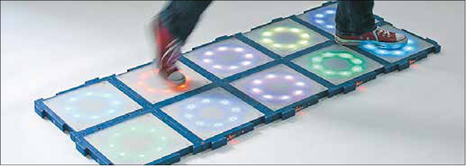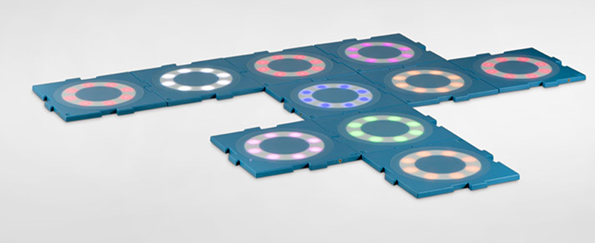
The elderly improve their balance through play
Latest technology will prevent fall accidents, as the first municipalities are ready to introduce illuminated tiles.
Magasinet Pleje [Care Magazine], 25th September 2015 - By Lotte Brochmann
ROBOT TILES Training on robot tiles that light up when you touch them can greatly improve the balance of the elderly, and strengthen their muscles and endurance. This was seen in a pilot project at a day centre in the Municipality of Gentofte. Now the Danish-developed technology is being distributed to the first
five municipalities, where it aims to help prevent fall accidents.
The interactive tiles fix together like jigsaw pieces to form a lit ‘hopscotch’ square, from which you jump from colour to colour. The games have various speeds and levels – some are physically challenging whilst others are more mentally demanding. Games include
stretching, memory and fast response movements.
During the project in Gentofte, the participants exercised on the tiles once a week for three months.
“We measured a significant improvement, particularly with regards balance, which is extremely important in preventing falls. In addition, improved endurance, strength, mobility and agility were also seen”, says the developer of the interactive Moto tiles, Professor Henrik Hautop Lund from the Center for Playware at DTU.
Play and quality of life
The elderly participants also said that training was fun, as it felt like they were playing a game when they were doing the exercises
and not like they were actually exercising.
“We felt it was important to develop playful technology that improved quality of life whilst exercising,” explains Henrik Hautop Lund.
“The playful tiles are linked to tablet computers where you can see how many points you have scored in the various games.
It can motivate as you can track your score and hopefully improve each game,” says Henrik Hautop Lund. Furthermore, the staff can document the effects of the exercises.
“The clever thing is that information is stored in the background. It happens automatically, and as an employee you do not have to remember whether you wrote something down or measured what you should,” he tells Magasinet Pleje.
The Moto tiles will now be introduced in the Municipalities of Gentofte, Frederiksberg, Odsherred, Furesø and Fakse.
This autumn, forty sets of tiles will be delivered to the five municipalities.
“We are on the brink of something amazing and we are very excited,” says Henrik Hautop Lund from the Center for Playware at DTU.

Five municipalities test the playful tiles
ROBOT TILES The municipalities of Frederiksberg, Fakse, Odsherred, Furesø and Gentofte are the first to introduce the new moto tiles.
Gentofte is the project leader for the introduction of the tiles, which will be done in several phases. During the first phase, the municipalities will test the interactive tiles.
In Gentofte and Furesø, the technology will be used as a preventive measure for elderly people who live in their own homes organised by day centres. In other municipalities, the tiles will be tested in connection with the rehabilitation and therapy of elderly people who have undergone a fall or have other conditions, says Torben H. D. Petersen to Magasinet Pleje. “In Gentofte we will also use the tiles in connection with therapy, but for intensive preventive therapy,” he says. He states that injuries resulting from falls currently cost a significant amount of money. Gentofte and the regional counties spend a combined sum of approx. DKK 10 million, with the municipal share being around DKK 4 million.

Social capital
In Gentofte the playful tiles will initially be distributed to the Vennerslund and Tværbommen day centres.
The municipalities’ two day centres have previously participated in a project involving the interactive tiles. The project demonstrated that the elderly improved their balance, endurance, mobility and agility during their use of the tiles. They also improved their mental health.
“I could see that people enjoyed playing on the tiles. It was fun and they played together,” says Torben H. D. Petersen.
The Municipality of Gentofte also wants to investigate how social capital can be created. Technology like the Moto tiles might help people meet and do things together, as well as form relationships, says Torben H. D. Petersen, Prevention Manager for the Municipality of Gentofte.
“It is possible to exercise and have fun at the same time”. Lisbeth Dittmann and Irma Kjeldsen from the Vennerslund Day Centre and Henrik Hautop Lund from DTU with the interactive tiles, which were introduced to the day centre in the autumn. (Ph: Lotte Brochmann)

ROBOT TILES The lighting Moto tiles will be issued to Vennerslund Day Centre in Gentofte in the autumn.
“We are really looking forward to using them again,” says the manager of the day centre, Irma Kjeldsen to Magasinet Pleje.
Vennerslund is already familiar with the technology through a pilot project at the day centre where the residents exercised on the tiles for three months. Participants were tested before, during and after the project and their balance, strength, endurance, mobility and agility greatly improved.
“They were able to do more and more. They became more mobile and could, for example, walk long distances and walk without a walking aid. The tiles were included as part of their exercise routine, as such they became accustomed to not using technical aids,” explains Lisbeth Dittman, Activities Assistant.
A community
At the beginning, some of the participants needed a helping hand, says Lisbeth Dittman, but later on in the project they were able to walk independently. “One of the participants was paralysed on one side, so we held him at first, as we were concerned that he would fall to one side - but he jumped around on the tiles without his stick. It was like he had been doing it every single day,” she smiles.
The participants were also good at encouraging each other to improve, she says, and a sense of community soon developed within the group. Not only did their balance improve on the playful tiles, so too did their laughter muscles!
The social aspect was tremendous, says Irma Kjeldsen, and competiveness in relation to improving and possibly becoming better than the participant next to them, was also apparent.
“There was a tremendous amount of laughter and I believe that this is an important part of the tiles too. You can exercise and have fun at the same time,” she says.
Furthermore, she stresses that Vennerslund welcomes all exercise equipment that incorporates an element of fun. For example, guests at the day centre can currently play darts and curling. “Exercise will be requested more and more in the future. So, looking ahead, we will focus on exercise at the activity centres as well,” she says.
Moto Tiles
The Moto tiles have been developed by Entertainment Robotics – a spin-off company of the Center for Playware at DTU.
In the autumn the interactive tiles will be introduced in the municipalities of Gentofte, Frederiksberg, Odsherred, Furesø and Fakse.
A.P. Møller and Chastine Mc-Kinney Moller’s General Fund donated DKK 6,545.000 to support and improve the technology.
Subsequent scientific studies demonstrate that after using the Moto tiles for only a short period of time, the balance of the elderly greatly improved. At the same time it was also documented that the strength, endurance, mobility and agility of the elderly improved when using the tiles. For example, the balance of the elderly in Gentofte improved by 66 per cent when they used the tiles once a week over a three-month period.
Danish design
The Moto tiles were designed in collaboration with a group of architects, Henning Larsen Architects, who were involved with the Copenhagen Opera House.
“Emphasis was placed on creating a good Danish design that would be attractive enough to have in an institution and fit in with the environment, as well as one that would be well-liked making you proud to have it,” says Professor Henrik Hautop Lund from the Center for Playware at DTU.
“And, of course, we also hoped that in the long-term the technology would be available in the international market following successful establishment in Danish institutions,” he says.



